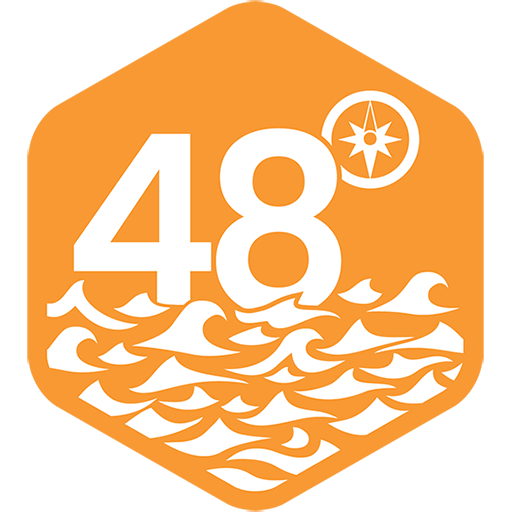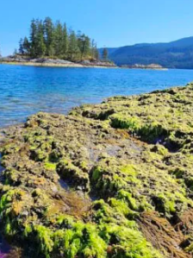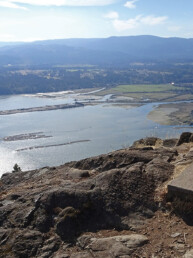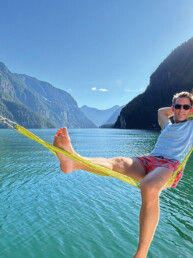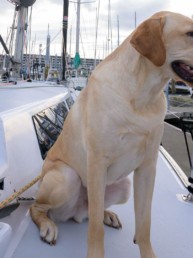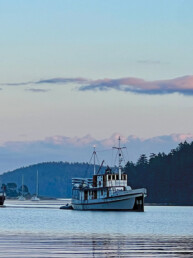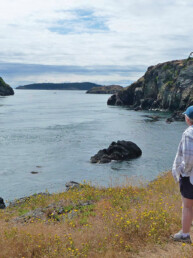With so many islands, parks, and recreational areas, from Sucia, to Stuart, to Spencer Spit, the San Juans are truly a unique and treasured cruising ground.
From the April 2008 Issue By Becky Coffield
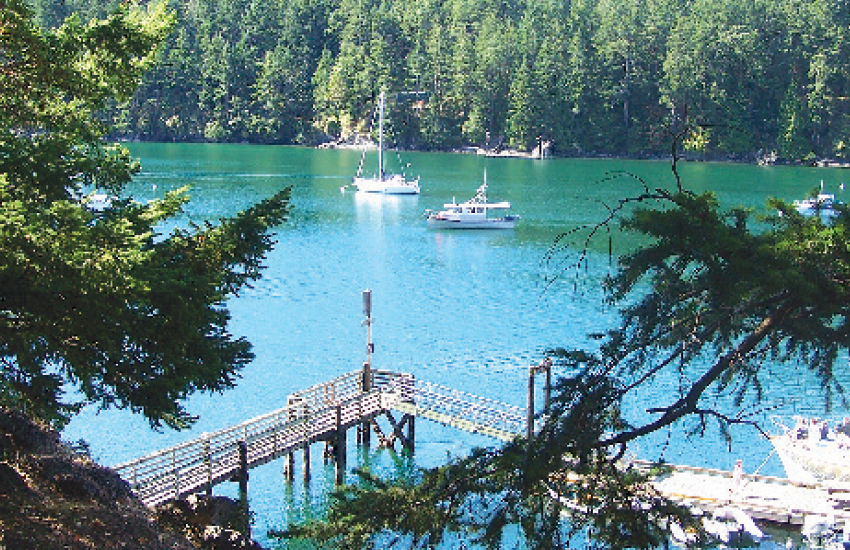
Just fifty nautical miles north of Seattle lies the unique, small archipelago of verdant, gem quality islands referred to simply as “the San Juans.” While most of the available land in the islands has fallen victim to development, wisely many areas have been set aside for the enjoyment of the thousands of boaters, campers and kayakers who journey to this region every year. Ranging in size from the miniscule two acre Blind Island State Park to Deception Pass State Park’s 2,337 acres, over two dozen state parks, designated recreational areas and marine parks, offer a smorgasbord of mooring buoys, anchorages, docks and campgrounds.
It is to Washington State’s credit that the San Juans have not been completely privatized like some of the Channel Islands of Southern California. San Juan Islanders are gracious, or at least forbearing, to the hordes of visitors that seasonally descend on the area. While most boaters rarely stray far from the poopdecks of their boats, others readily take advantage of the trails and beaches available on the island parks. Many of the marine parks are situated on their own entire little island, such as Sucia, Matia, Patos, Jones Island and Turn Island, while others are situated on the now over-populated islands themselves. Where vacationers and residents share space, problems occasionally do arise, mostly due to hikers inadvertently stepping on someone’s property.
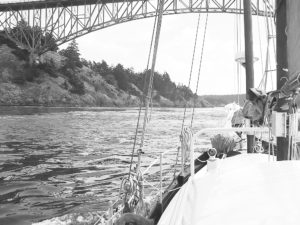
Three outstanding parks located in the western part of the San Juans are Jones Island State Park, Turn Island State Park and Stuart Island Marine Park.
While Stuart Island’s park is bordered by private lands on the west and east sides, boaters have access to Reid and Prevost Harbors, protected anchorages with mooring buoys and floats, each on opposite sides of the park. The small park is ringed with walking trails, although a county road offers a longer expedition, including a lengthy jaunt to the historic Turn Point Lighthouse. The lighthouse, built over a century ago, is now automated and under the auspices of the BLM. Be sure to take some money along on this trek. You’ll have a chance to shop at the Stuart Island Treasure Chest sponsored by the Pirates of the San Juans. The t-shirts are irresistible! Fishing around the island is excellent.
Jones Island Marine Park, encompassing an entire 179 acre island, a mere three miles from Deer Harbor and seven miles from Friday harbor, offers unfettered recreational opportunity. There are only two anchorage/mooring areas on the island, and the north side seems to attract the most boats, probably because the south side anchorage can be a bit rolly due to traffic in North Pass to and from Deer Harbor and Pole Pass. The southern anchorage settles nicely in the evening, however, and remains calm until morning.
Besides nice walking trails with excellent views, the island also has water, bathroom facilities, wonderful beaches at all but high water, and beautifully situated campsites. There are good landing areas for kayakers also. Fishing appears to be good in Spring Passage on the east side of the island.
Turn Island State Park, the surprising find of the summer, is literally a mere stone’s throw from Friday Harbor. The island park has two mooring buoys, campsites, wonderful beaches, and a scenic trail around the perimeter of the island. It’s an easy skiff run to Friday Harbor (assuming one has an outboard) for supplies or dinner out. Fishing looks promising, but to date I can’t vouch for it.
San Juan Island offers some fascinating and pleasant parks. English Camp Historical State Park in Garrison Bay and Griffin Bay Park, located adjacent to American Camp Historical Park are worth a visit. Both parks are heavily populated during the summer season, particularly English Camp at Garrison Bay which often holds over fifty boats in the shallow, secure anchorage. Both parks have pleasant, easy walks with interesting historical data along the way. Neither park permits overnight camping. Griffin Bay Park has a hike to Mt. Finlayson which offers beautiful views on clear days. Be careful when anchoring in Griffin Bay, however, as there are submerged rocks and piling, and the anchorage is only semi-protected.
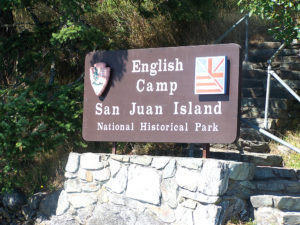
While Lopez’s 82 acre Odlin Park, situated along Upright Channel can be a tad rolly, it does offer campsites, good anchorage and a beautiful, sandy, 4,000 foot long stretch of beach. There are several walks, but no real hiking. Note also the three overnight buoys on the south side of Flat Point.
All of the sites situated in the western half of the San Juans are well maintained. The modest fee of $10.00 a night is a bargain for a buoy or campsite. Unfortunately, some people fail to pay this small fee which helps support the parks. There is little land left for vacationers to enjoy, so those who don’t pay put the continuation of the parks in jeopardy.
There are over a dozen popular parks located in the central and eastern portions of the San Juan Islands. Ranging from Patos, the northern most park, to James Island, these parks provide a multitude of boaters, campers and kayakers a wonderful opportunity to enjoy their recreational pursuits.
Sucia Island, probably the most popular of the parks, offers a plethora of buoys and bay inlets with excellent anchorage. Numerous, well marked trails criss-cross the island and give cooped up boaters ample opportunity to get some exercise. Sucia is particularly special because it was purchased by a group of sixty-five cooperating yacht clubs and businesses to be kept strictly for boater use for all time. This was a tremendous contribution, and these organizations truly merit every boater’s thanks and appreciation. Even with all the trails, having a motorized skiff (or a kayak) is almost mandatory to help one explore all the many small island fingers with their inlets and coves.
Matia Island State Park, a mere three miles east of Sucia, is the quiet beauty of the two islands. Although, with a lot of care, anchorage is possible on the southern and eastern sides, only the north cove has two mooring buoys and a dock. Due to the intense swirling currents that run through this cove, it is not advisable to anchor in this area. A trail meanders along the perimeter of the island and there are massive trees on display.’
Patos Island Marine State Park, the most northern island in this group of three, is the least visited, which of course makes it an ideal spot for some boaters. The only real protected harbor on the island is Active Cove. Moorage is limited and can be very rolly. There are two mooring buoys and a little room for more boats to anchor if they watch the tides and weather very carefully. The entry to the cove is narrow, shallow and has some large rocks. There are 207 acres to roam, however, and over 23,000 feet of shoreline. We understand they’ve done a lot of work on the lighthouse, which is always worth a visit.
Fifty-five acre Clark Island is probably best suited for kayakers. Although there are mooring buoys and anchorage available, because the island is basically in Rosario Strait with a shipping channel adjacent, it can be windy and rolly. While Clark Island is long and narrow, it does have extremely nice beaches. Nearby, the six acre Doe Island off the southeast side of Orcas Island, has a float available in the summer months, and anchorage for small boats is best on the east side in the channel between Doe and Orcas. There is a nice trail circling the little island.
Obstruction Pass Recreational Area is an 80 acre Department of Natural Resources park on the western side of Obstruction Pass. It’s a unique area and worth visiting if a mooring buoy is available.
Heading in a southerly direction, Spencer Spit State Park is another immensely popular area. Anchorage is good, mooring buoys are plentiful, and crabbing is excellent. The spit is wonderfully sandy and makes a great relaxation and play area. The beach gradually tapers off, so the truly bold and young can easily enjoy playing in the water.
James Island Marine Park is beautiful but difficult. The west side has a cove with a pier and dock, but anchorage is iffy as the current can swirl about. There are really no other anchorages except for the east side which has some mooring buoys. It is open to Rosario Strait so weather or commercial traffic can make for an uncomfortable stay. There’s a small cove on the north end also. This area can be very rolly due to daytime traffic through Thatcher Pass. A good idea, if one needs to anchor, is to anchor behind Decatur Head to the west of the island.
Although James Island looks so inviting, it may be best suited for day visits or camping kayakers, just like Burrows Island Marine Park, located on the east side of Burrows Island. This island has anchorage, but watch the depthsounder! It shallows quickly and low water may leave you aground, which eliminates the use of the one mooring buoy for most deep draft vessels. The beach is nice, but other than two campsites and an outhouse, there’s not much else. No trails. Just vertical rock cliffs. Because the beach provides a nice landing area, kayakers may best enjoy this park. Technically this park is not really in the San Juans.
Cypress Island, bordering the San Juans, hosts three recreational sites. Pelican Beach Recreational site, 211 acres, is located on the northern end of Cypress Island, while Cypress Head Recreational Site offers a long stretch of waterfront and four mooring buoys. On the west side of Cypress is Strawberry Island Recreational Site, another site probably more appropriate for kayakers.
Saddlebag Island State Park, far to the east and just north of Anacortes, has decent anchorage on the north end, but the 23 acre island is small and exposed. Many anchor there for the day to drop their crab pots.
Finally, there’s Deception Pass State Park, a 2, 337 acre park located on the north shore of Deception Pass, is an appropriate park to begin, or end, one’s journey through the parks of the San Juans. The park hosts mooring buoys, floats, campsites, showers, etc. There’s plenty of acreage to roam and plenty of space to plan the journey awaiting, or to reminisce on the one you’ve just had. You can celebrate your passage through Deception Pass going in, or, or prepare yourself for the upcoming thrill going out. Really, it’s not that bad, but you have to pay very close attention to the tides
In total, the San Juan Islands offer over two dozen parks for all to enjoy. Who would dream that these islands, once sparsely populated, would become home to so many. An island can only support so many people, but an island park can greet people throughout the busy season and recoup through the long winter months.
With so many islands, parks, and recreational areas, from Sucia, to Stuart, to Spencer Spit, the San Juans are truly a unique and treasured cruising ground.
48° N
Editor
48° North Editors are committed to telling the best stories from the world of Pacific Northwest boating. We live and breathe this stuff, and share your passion for the boat life. Feel free to keep in touch with tips, stories, photos, and feedback at news@48north.com.
